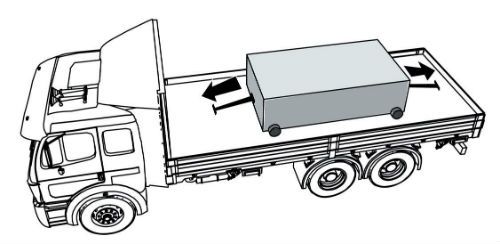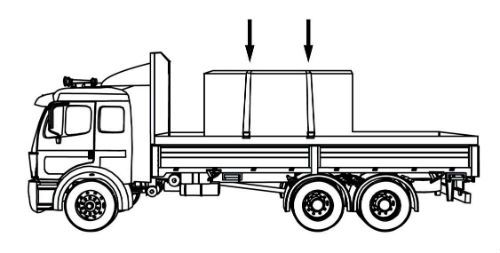CDL Practice Tests: Flatbed Cargo Securement
Choose A Section:
Go!When securing flattened or crushed cars on a vehicle with containment on 2 sides, how many tiedowns, at minimum, are required?
- 3
- 1
- 2
- 4
Option 3:
Has containment walls on two sides that:
- Extend to the full height of the load.
- Block against cargo movement in the forward and rearward.
Secures each stack of vehicles with a minimum of three tiedowns, each having a minimum WLL of 2,268 kg (5,000 lb.).
Methods of securing building materials against forward motion include:
- Using tiedowns.
- Employing blocking equipment.
- Placing bundles against the bulkhead or front end.
- These are all valid methods.

-
Option #1
Place bundles against bulkhead/front end structure.
-
Option #2
When different tiers need to be secured, use a combination of blocking equipment and tiedowns.
When securing a single metal coil with eyes vertical:
- These are all requirements.
- Attach at least one tiedown diagonally across eye of coil from left side of vehicle to right side of vehicle.
- Attach at least one tiedown diagonally across eye of coil from right side of vehicle to left side of vehicle.
- Attach at least one tiedown over eye of coil from side-to-side.
To prevent the coil from tipping forward, rearward, and sideways, arrange tiedowns to include the following:
- Attach at least one tiedown diagonally across eye of coil from left side of vehicle to right side of vehicle.
- Attach at least one tiedown diagonally across eye of coil from right side of vehicle to left side of vehicle.
- Attach at least one tiedown over eye of coil from side-to-side.
All of the following are requirements for dividing vehicles over 33ft except:
- Each tiedown must be fastened below the logs on each side of the center stake.
- Vehicle must be divided by center stakes into sections of staggered length.
- Vehicle must be equipped with center stakes or comparable devices.
- Each tiedown must secure the highest log on each side of the center stake.
Requirements for dividing vehicles over 10m (33 ft)
Vehicles over 10 m (33 ft) must be equipped with center stakes, or comparable devices, to divide it into sections of equal length.
Each tiedown must:
- Secure the highest log on each side of the center stake.
- Be fastened below these logs.
When securing concrete bell pipe in multiple complete tiers, all of the following are true except:
- Stack the tiers in pyramid fashion.
- All of these apply.
- Bells of the upper tiers must all be on the opposite side of the vehicle from the bells of the tier below.
- Bells of the bottom tier must all be on the same side of the vehicle
More than one tier with complete tiers

Bells of the bottom tier must all be on the same side of the vehicle
Bells of the upper tiers must be are on the opposite side of the vehicle from the bells of the tier below.
When securing paper rolls with eyes vertical in a sided vehicle all of the following are acceptable except:
- Placing the rolls against each other.
- Placing rolls against the doors.
- Placing the rolls against other cargo.
- Placing rolls against the front and walls of the vehicle.
- Place paper rolls together in a group so that the structure of the group can be maintained.
- Place paper rolls against:
- The front and walls of the vehicle
- Each other
- Other cargo
Specific cargo securement rules on automobiles and light trucks apply to vehicles of what weight?
- It depends on what the vehicle is used for.
- 10,000 lbs or less
- 4,500 lbs or less
- 12,000 lbs or less
What Does This Section Cover?
The requirements in this section apply to the transportation of automobiles, light trucks, and vans that individually weigh 4500 kg (10,000 lb.) or less.
As part of their pre-trip cargo securement inspection, drivers should:
- Inform carrier of any inadequate packaging.
- Make sure cargo is properly secured.
- Check for anything that will obscure their vision.
- All of these apply.
Driver inspection checklist:
Pre-Trip
- Make sure that cargo is properly distributed and adequately secured (in other words, according to the Standard).
- Make sure that all securement equipment and vehicle structures are in good working order and used consistent with their capability.
- Stow vehicle equipment.
- Make sure that nothing obscures front and side views or interferes with the ability to drive the vehicle or respond in an emergency.
-
Inform carrier if packaging is not adequate. For example:
- Banding is loose or not symmetrical on package.
- Banding attachment device(s) are inefficient.
- Wrapping is broken or ineffective.
- Pallets are broken.
How many anchor points should be used to secure an intermodal container on a chassis vehicle?
- 2 latches in the middle, and 2 at the rear.
- 2 latches each at or near both the front and rear.
- 2 latches in the front and 2 in the middle.
- 4 latches total, anywhere on the trailer.
Secure the front and rear of the container independently.
- 2 latches on the chassis engage anchor points towards or at the front of the container.
- 2 latches on the chassis engage anchor points towards or at the rear of the container.
What is a rub rail?
- A device placed between the deck of a vehicle and car or between articles of cargo, intended to provide greater friction than exists naturally between these surfaces.
- A rail along the side of a vehicle that protects the side of the vehicle from impacts.
- A strip of material that may be used to unitize articles and is tensioned and clamped or crimped back upon itself. (same as "Strapping")
- A platform or tray on which cargo is placed so that it can be handled as an article. (Same as "Skid")
Rub Rail:
A rail along the side of a vehicle that protects the side of the vehicle from impacts.
About The Flatbed Cargo Securement CDL Manual
Studying the flatbed cargo securement CDL manual is not a requirement for getting your CDL permit or license. It is required knowledge for flatbed drivers.
Some questions you should be able to answer for flatbed cargo securement:
- What is the minimum Working Load Limit of a tiedown used to secure logs?
- What is the minimum weight of a shipment of paper rolls that would require specific securement requirements?
- When securing concrete pipe over 45 inches loaded crosswise, which direction must the tiedowns on the front half of the load run?
- What is a cab shield?
- When securing concrete pipe over 45 inches loaded crosswise, which direction must the tiedowns on the rear half of the load run?
- What is a dunnage bag?
- Who is responsible for inspecting securing devices and cargo within the first 50 miles?
- How many tiedowns are required on a stack of shortwood loaded crosswise?
- What is the minimum working load limit of each tiedown used to secure crushed or flattened vehicles?
- Define 'bolster'
- What is a hook-lift container?
- When a tiedown is attached directly to the cargo, what is the ideal angle where it attached to the vehicle?
What is a securing device?
Any device specifically manufactured to attach or secure cargo to a vehicle or trailer:
- Synthetic Webbing
- Chain
- Wire rope
- Manila rope
- Synthetic rope
- Steel strapping
- Clamps and latches
- Blocking
- Front-end structure
- Grab hooks
- Binders
- Shackles
- Winches
- Stake pockets
- D-rings
- Webbing ratchet
- Bracing
- Friction mat
What is a tiedown?
A combination of securing devices that forms an assembly that:
- Attaches cargo to, or restrains cargo on a vehicle.
- Is attached to anchor point(s).

Some tiedowns are attached to the cargo and provide direct resistance to restrain the cargo from movement.

Some tie-downs pass over or through the cargo. They create a downward force that increases the effect of friction between the cargo and the deck. This friction restrains the cargo.
 Related Cargo Securement Terms That Every Driver Should Know:
Related Cargo Securement Terms That Every Driver Should Know:
-
Tiedown:
A combination of securing devices which form an assembly that attaches cargo to, or restrains cargo on, a vehicle or trailer, and is attached to anchor point(s).
-
Contained:
Cargo is contained if it fills a sided vehicle, and every article is in contact with or sufficiently close to a wall or other articles so that it cannot shift or tip if those other articles are also unable to shift or tip.
-
Blocking:
A structure, device, or another substantial article placed against or around an article to prevent horizontal movement of the article.
How should tiedowns be attached?
Tiedowns can be used in two ways:
-
Attached to the cargo:
- Tiedowns attached to the vehicle and attached to the cargo.
- Tiedowns attached to the vehicle, pass through or aroundan article of cargo, and then are attached to the vehicle again.
-
Pass over the cargo:
- Tiedowns attached to the vehicle, passed over the cargo, and then attached to the vehicle again.
Tiedown placement:

Place the tiedown as close as possible to the spacer.
Position the tiedowns as symetrically as possible over the length of the article.

Position the tiedowns to preserve the integrity of the article.







 TT On Facebook
TT On Facebook